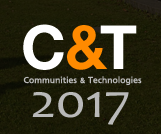About the Workshop
Context
Unbound and unforeseen collaborative situations can be found in many domains, like e-learning, healthcare, and crisis management. For example, in the context of healthcare, actors coming from different organizations (e.g. hospital, municipality, general practitioners) have to coordinate their practices to enable or enhance the management of the patient situation [1]. These actors have to improvise ways of coordinating their work across organizational and other boundaries. Additionally, each patient represents a new case that requires different arrangement with different actors. Many care and healthcare scenarios also depends on informal actors, such as family members and volunteers, and actors that see their business or core activity to be something very different than being a collaborative part in care work, such as taxi organizations and their drivers, and this further complicates the collaborative effort [3]. In such cross-organizational and multi-actor collaborative scenarios and contexts it can be useful to support potential collaborations between indeterminate actors. The challenge is how to design for such future collaboration that might emerge out of a new or isolated need to solve an issue at hand and are existing terms, such as Community, Organization or Group, suitable to describe the collaborative entities in such situations? We might have to consider rethinking the way we understand collaboration, the actors and contexts involved, and the methods we use to design support in such contexts.
FRAMING
For this workshop, we are interested in concepts that can help researchers to identify and account for emergent, temporary,
and improvised collaborative practices. These collaborations emerge at the boundary of more established collaborative work
settings and practices, like informal care of an older adult referred to professionals and municipality-organized home-care work.
Furthermore, we are interested in the methods that integrate all the concerned actors in the design process.
In other words, how we design to promote, and even enable, the initiating of new collaborations.
Thus, taken the above aspects of collaboration in consideration, we need concepts that describe the dynamic arrangements between
fleeting and recurrently changing actors throughout a collaborative process.
Engeström and his colleagues have proposed the term "knotworking" [4] to describe a cross-boundary way of organizing work and collaboration.
In knotworking, collaboration occurs in episodes depending on the requirement of the current situation.
People involved in a knotworking processes create and take part in improvised collaboration groups — called knots — that gather otherwise
loosely connected actors. We consider "knotworking" as a good candidate to describe how the groups emerge on the borders.
However, we need more details on how collaboration actually occurs to help CSCW researchers and practitioners in designing
support for the actors involved in a knotworking process [1].
There are also other candidate concepts that can help us better understand these collaborations.
For example, Zacklad proposes the term "communities of action" to describe entities that form around collaboration across the boundaries
of established communities [6]. Communities of action are thus " small groups which actively and thus to some extent rationally pursue
explicit goals while relying on a tightly woven fabric of relationships to promote mutual sympathy and the mimetic learning that is assumed
to characterize primary groups and communities of practice" [5, p.193].
Similarly, Le Dantec and DiSalvo's application of Dewey's concept of Publics in their work on the formation of publics,
also brings forward the emergence of groups of people around a shared issue of concern.
They discuss the formation of publics as an ad-hoc way of participation where a common goal is to be achieved through
Infrastructuring and Attachments [3]. In many ways, Publics may seem similar to the above description of emergent collaborations.
However, we see that collaborative work can be ongoing while the involved actors may change over time compared with the formation
of Publics and attachments that may be more fleeting and exists only for a brief moment of time.
In this workshop, we propose to open the discussion on how to research and design for the kinds of emergent,
temporary collaborations across established community and organizational boundaries, and the people who participate in it.
We will try to address the question of whether the concepts related to communities, such as communities of action and publics,
or collaborative work, such as knotworking, help us? We will discuss and reflect on these concepts as well as other promising
ones brought in by the participants. In addition to concepts, we will also discuss methods that enable the understanding of
intertwined collaborative practices across community and organizational boundaries, and how to design to support them.
References
[1] Abou Amsha, K. 2016. Supporting collaboration in knowtworking: a design case study in home care. Troyes.
[2] Bødker, S. et al. 2016. Happenstance, Strategies and Tactics: Intrinsic Design in a Volunteer-based Community. Proceedings of the 9th Nordic Conference on Human-Computer Interaction (New York, NY, USA, 2016), 10:1‐10:10.
[3] Bossen, C. et al. 2013. CareCoor: Augmenting the coordination of cooperative home care work. International Journal of Medical Informatics. 82, 5 (May 2013), e189‐e199.
[4] Engeström, Y. et al. 1999. When the center does not hold: The importance of knotworking. Activity theory and social practice. S. Chaiklin et al., eds. Aarhus University Press. 345‐374.
[5] Le Dantec, C.A. and DiSalvo, C. 2013. Infrastructuring and the formation of publics in participatory design. Social Studies of Science. 43, 2 (Apr. 2013), 241‐264.
[6] Zacklad, M. 2003. Communities of action: a cognitive and social approach to the design of CSCW systems. Proceedings of the 2003 international ACM SIGGROUP conference on Supporting group work (New York, NY, USA, 2003), 190‐197.
